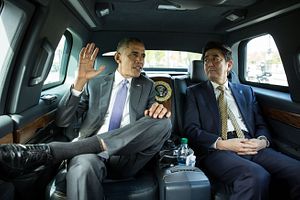With the signing ceremony in Auckland, New Zealand today, the Trans-Pacific Partnership has taken a significant, although symbolic, step forward. The text agreed upon in October 2015 was reached after five years of formal negotiations, which themselves grew out of U.S. negotiations with the four members of the Trans-Pacific Strategic Economic Partnership Agreement (Brunei, Chile, Singapore, New Zealand). The TPP includes 12 states (Australia, Brunei Darussalam, Canada, Chile, Japan, Malaysia, Mexico, New Zealand, Peru, Singapore, the United States, and Vietnam) which together represent nearly 40 percent of global GDP and a third of world trade. The agreement is perhaps the most comprehensive, if not longest, free trade agreement ever concocted.
At the signing ceremony, New Zealand Prime Minister John Key called the signing “an important step” but noted that the the agreement “is still just a piece of paper, or rather over 16,000 pieces of paper, until it actually comes into force.”
Now the hard part begins: ratification. There are two paths to the TPP coming into force. The first is simple to explain: the TPP will come into force two months after all the original signatories complete their own domestic ratification procedures.
The second route to entry into force is decidedly more likely. As there is significant push back in some signatory countries, it’s reasonable to assume at least one will fail to ratify the agreement. In that event, the agreement can still come into force if at least six countries, which between them represent at least 85 percent of the total GDP of the original 12, have ratified it within two years.
This is the mark everyone will be watching. The TPP will truly be decided between the United States and Japan, which together represent just under 80 percent of the total GDP of the signatories. As Ankit Panda noted in October, “Basically, the TPP can’t come into force if either of these states fail to ratify the agreement in their domestic legislatures because there would be no way for the remaining signatories to fulfill the 85 percent of GDP requirement (even if the United States and all states but Japan ratify, the eleven would stand at 83 percent of GDP).”
And to complicate matters, it’s an election year in the United States. The U.S. Senate is unlikely to tackle the deal until after the November elections. U.S. Senate Majority Leader Mitch McConnell told reporters recently, “I have some problems with the agreement.” He went on to advise that discussing the ratification be held off until after the election: “With both the Democratic candidates for president opposed to the deal and a number of presidential candidates in our party opposed to the deal, it is my advice that we not pursue that, certainly before the election.”
That several candidates have made statements in opposition to the TPP is not necessarily an indicator that as president they would stand in its way. Each signatory country has to deal with its own domestic ratification procedures and domestic concerns regarding the broad free trade agreement. As evidenced by the large protests in Auckland during the signing ceremony, there remains much skepticism regarding the deal’s effects, particularly on domestic workers.
In a statement, U.S. President Barack Obama said the deal “allows America – and not countries like China – to write the rules of the road in the 21st century, which is especially important in a region as dynamic as the Asia-Pacific.”

































